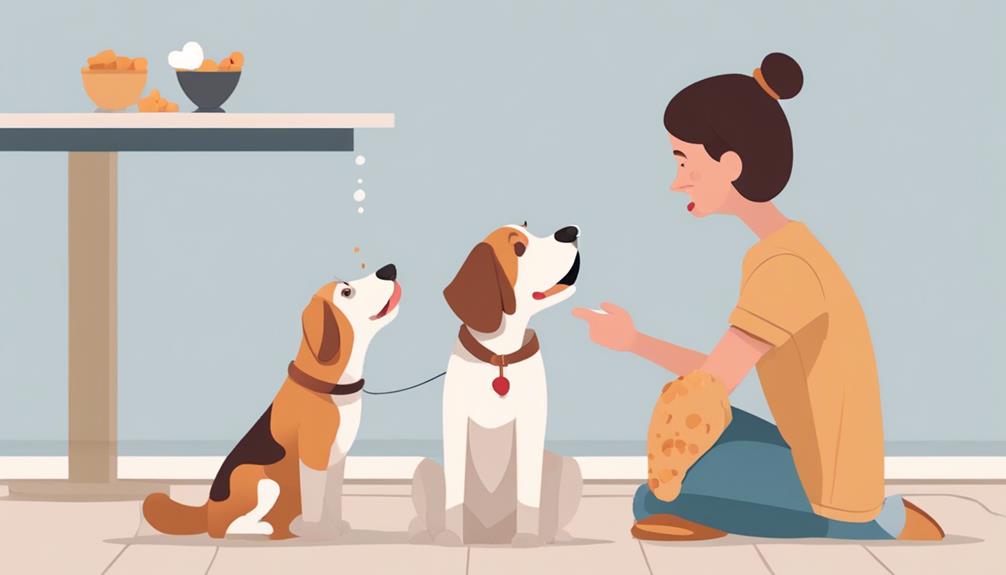What Influences Dog Behavior and How to Modify It?
Imagine your dog's behavior as a complex puzzle, with each piece representing a different influence – from their breed characteristics to the environment they are in. Understanding these factors is crucial in shaping their actions.
But what happens when a piece doesn't quite fit? How do you modify behaviors that seem ingrained?
In this discussion, we will explore the intricate web of influences on dog behavior and discover effective strategies to help your furry companion become the best version of themselves.
Canine Social Hierarchy
Understanding the canine social hierarchy is crucial for comprehending your dog's behavior within a pack setting. In pack dynamics, dogs establish leadership roles through a structured hierarchy based on dominance theory. This pack structure influences how dogs interact with one another and respond to their environment.
Within a pack, each dog has a specific rank or status in relation to others. This hierarchy helps maintain order and minimize conflicts. Dogs with higher ranks may display dominant behaviors, such as controlling access to resources like food and toys. On the other hand, lower-ranking dogs may show submissive behaviors to avoid confrontations with higher-ranking pack members.
Leadership roles in a pack aren't fixed and can change based on various factors like age, size, and assertiveness. Understanding these dynamics can help you interpret your dog's behavior and address any issues that may arise within a group of dogs. By recognizing the pack structure and leadership roles, you can better support your dog in social settings and prevent potential conflicts.
Breed Characteristics and Temperament
To better comprehend your dog's behavior, consider how breed characteristics and temperament play a significant role in shaping their interactions with other dogs and their environment. Different breeds have genetic predispositions that influence their behavior, making some more prone to certain behaviors than others. Understanding your dog's breed-specific traits can help you tailor your approach to behavior modification effectively.
- Genetic Predispositions: Each breed has unique genetic traits that can influence their behavior, such as herding instincts in Border Collies or protective tendencies in German Shepherds.
- Temperament: The overall personality and disposition of a breed, like the energetic nature of a Labrador Retriever or the independent spirit of a Siberian Husky, can impact how they interact with their environment.
- Socialization Needs: Some breeds require more socialization to prevent behavioral issues like aggression or fearfulness towards others.
- Training Methods: Understanding your dog's breed-specific characteristics can help in choosing the most suitable training methods for effective behavior modification.
Environmental Influences on Behavior
Environmental factors significantly impact your dog's behavior, shaping how they respond to stimuli and interact with their surroundings. Diet plays a crucial role in behavior; what your dog eats can affect their energy levels, mood, and overall well-being. A balanced diet with the right nutrients can help maintain a stable temperament and prevent behavioral issues.
Likewise, exercise is key to a dog's mental and physical health. Sufficient physical activity can reduce anxiety, boredom, and destructive behaviors. Regular walks, playtime, and mental stimulation are essential for a well-rounded and contented pup.
Beyond diet and exercise, the physical environment your dog is in can also influence their behavior. A stimulating environment with toys, safe spaces, and social interactions can promote positive behaviors and prevent boredom or anxiety. Conversely, a chaotic or stressful environment can lead to fear, aggression, or other behavioral problems. Ensuring a comfortable and enriching environment for your dog is crucial for their overall well-being and behavior.
Learning and Conditioning in Dogs
Learning and conditioning play crucial roles in shaping your dog's behavior and responses to various stimuli. Classical conditioning involves associating two different stimuli to trigger a learned response, while operant conditioning focuses on the consequences of a behavior to modify its occurrence in the future. Here are some key points to consider:
- Classical Conditioning: Your dog can learn to associate a neutral stimulus with a significant event, like the sound of a treat bag with the excitement of getting a treat.
- Operant Conditioning: By rewarding desired behaviors and ignoring or correcting unwanted ones, you can effectively train your dog to exhibit the behaviors you want.
- Reinforcement: Positive reinforcement, like treats or praise, strengthens the likelihood of a behavior repeating. Negative reinforcement involves removing an unpleasant stimulus to increase the occurrence of a behavior.
- Punishment: Applying positive punishment introduces an unfavorable consequence to decrease undesired behaviors, while negative punishment involves removing a positive stimulus to reduce the likelihood of a behavior happening again.
Fear and Anxiety Triggers
Understanding the triggers for fear and anxiety in dogs is essential for effectively managing their behavior and well-being. Dogs may exhibit fear and anxiety due to trauma responses, which can stem from past negative experiences or lack of socialization. Recognizing these triggers is the first step in helping your dog overcome their fears.
Coping mechanisms such as trembling, hiding, or excessive barking are common signs that your dog is feeling anxious or fearful. To address these issues, desensitization and counter conditioning techniques can be utilized.
Desensitization involves gradually exposing your dog to the source of fear in a controlled manner, helping them build confidence and reduce their anxiety over time. Counter conditioning focuses on changing your dog's emotional response to the trigger by associating it with positive experiences.
Aggression in Canines
Recognizing signs of aggression in your dog is crucial for addressing and managing this behavior effectively. Aggression in canines can stem from various factors, including dominance hierarchy and pack mentality. It's essential to understand the underlying reasons for your dog's aggression to address it appropriately.
- Dominance Hierarchy: Dogs are pack animals that follow a social structure where dominant and submissive roles are established. Aggression may arise if your dog feels the need to assert dominance.
- Pack Mentality: Dogs may exhibit aggressive behavior when they perceive a threat to their pack or family members, including their human guardians.
- Resource Guarding: Dogs can become aggressive when they feel the need to protect valuable resources like food, toys, or sleeping areas.
- Territorial Aggression: Dogs may display aggression to defend their territory, such as their home or yard, from perceived intruders.
Understanding these factors can help you address and modify your dog's aggressive behavior effectively.
Positive Reinforcement Training Techniques

When training your dog using positive reinforcement techniques, consistency is key to reinforcing desired behaviors effectively and promoting a strong bond between you and your furry companion. Clicker training, where a click sound is used to signal correct behavior followed by treats, can be a powerful tool in this type of training. Ensure you have a clicker and high-value treats ready before starting the training session.
Consistency is vital in positive reinforcement training. Always reward the behavior you want to encourage immediately after it happens, so your dog associates the action with the reward. This helps your dog understand what you expect and encourages them to repeat the behavior.
Seeking Professional Behavior Help
If you're struggling to address challenging behaviors in your dog, seeking professional behavior help can provide you with the guidance and expertise needed to create positive changes. Behavior therapy and trainer referrals are valuable resources to assist in modifying your dog's behavior effectively.
Here are some benefits of seeking professional behavior help:
- Specialized Expertise: Behavior therapists are trained to understand the root causes of your dog's behavior and can tailor a treatment plan to address specific issues.
- Structured Approach: Professional behavior help often follows a structured approach that includes assessment, intervention, and follow-up to ensure progress.
- Customized Training: Trainers can provide personalized training programs that suit your dog's unique personality and learning style.
- Long-Term Support: Seeking professional help can offer ongoing support and guidance as you work towards improving your dog's behavior.
Frequently Asked Questions
Can a Dog's Behavior Be Influenced by Their Diet or Nutrition?
Yes, a dog's behavior can be influenced by their diet. Food quality plays a crucial role in how your pet behaves. By providing nutritious meals, you can positively impact their energy levels and overall demeanor.
Coupled with proper training methods, a balanced diet can enhance your dog's learning capabilities. Remember, a healthy diet is just one part of the equation; exercise routine and behavior therapy also play significant roles in shaping your dog's behavior.
How Do Factors Such as the Weather or Season Affect a Dog's Behavior?
Incorporate seasonal changes and weather patterns when considering your dog's behavior. Seasonal changes can impact their activity levels and mood. For instance, during hot summers, dogs may prefer more indoor activities.
Weather patterns, like thunderstorms, can also affect their behavior. Ensure proper exercise and socialization throughout all seasons to help your dog adjust and maintain a healthy demeanor.
Can a Dog's Behavior Be Influenced by the Presence of Other Animals in the Household?
Yes, the presence of other animals in your household can greatly influence your dog's behavior. Social dynamics between pets can impact how they interact with each other and with you.
Using proper training techniques and behavioral modifications can help manage these household dynamics. Consistent reinforcement and positive interactions can create a harmonious environment for all the animals in your home.
Are There Specific Ways to Address a Dog's Behavior That Is Influenced by Past Traumatic Experiences?
When dealing with a dog's behavior influenced by past trauma, specific training techniques and rehabilitation methods can help. Behavior modification and trust building are crucial in these situations.
By using positive reinforcement, patience, and consistency, you can gradually address and improve your dog's behavior.
Creating a safe and predictable environment, along with seeking professional guidance if needed, can significantly aid in the process of overcoming past traumatic experiences in dogs.
How Can a Dog's Behavior Be Impacted by Changes in Their Routine or Environment?
When your routine or environment changes, your behavior can be affected. Consistency in training methods helps you adapt to these changes.
Regular exercise and enrichment activities can also improve your behavior. Remember, a stable routine and engaging activities will positively influence how you respond to alterations in your surroundings.
Conclusion
In conclusion, understanding the various factors that influence dog behavior, such as social hierarchy, breed characteristics, environment, learning, fear triggers, and aggression, is key to modifying and shaping their behavior.
By using positive reinforcement training techniques and seeking professional help when needed, you can effectively address behavioral issues in your furry friend.
Remember, with patience and consistency, you can help your dog become a well-behaved and happy companion.
